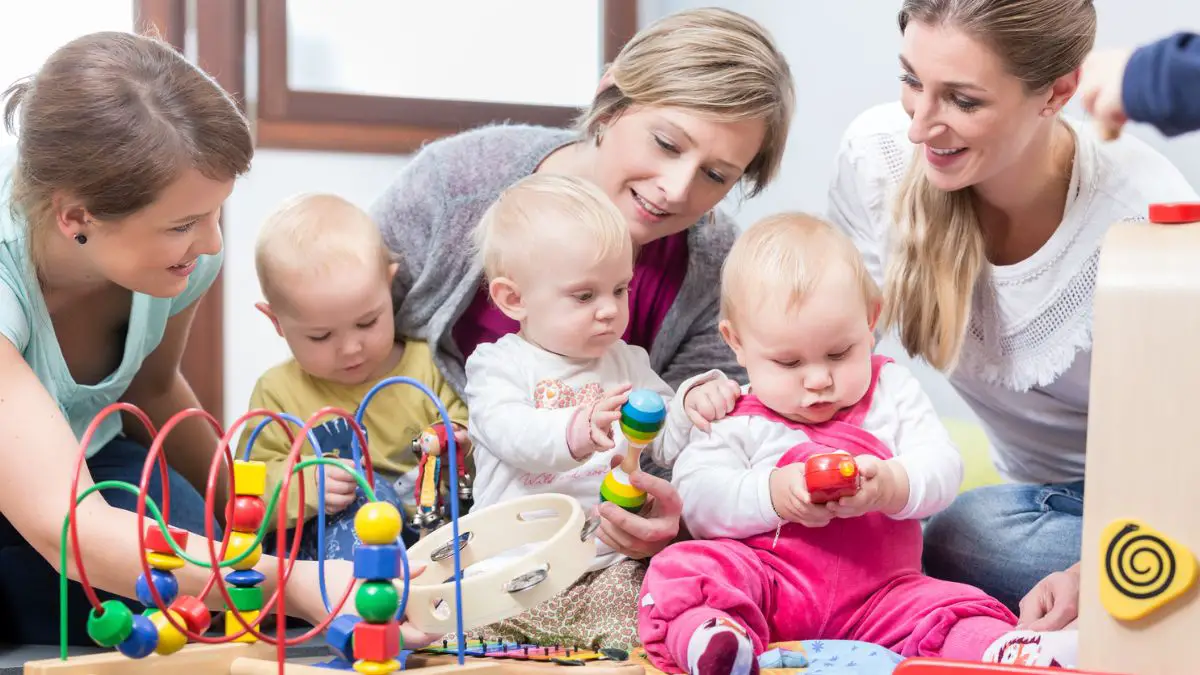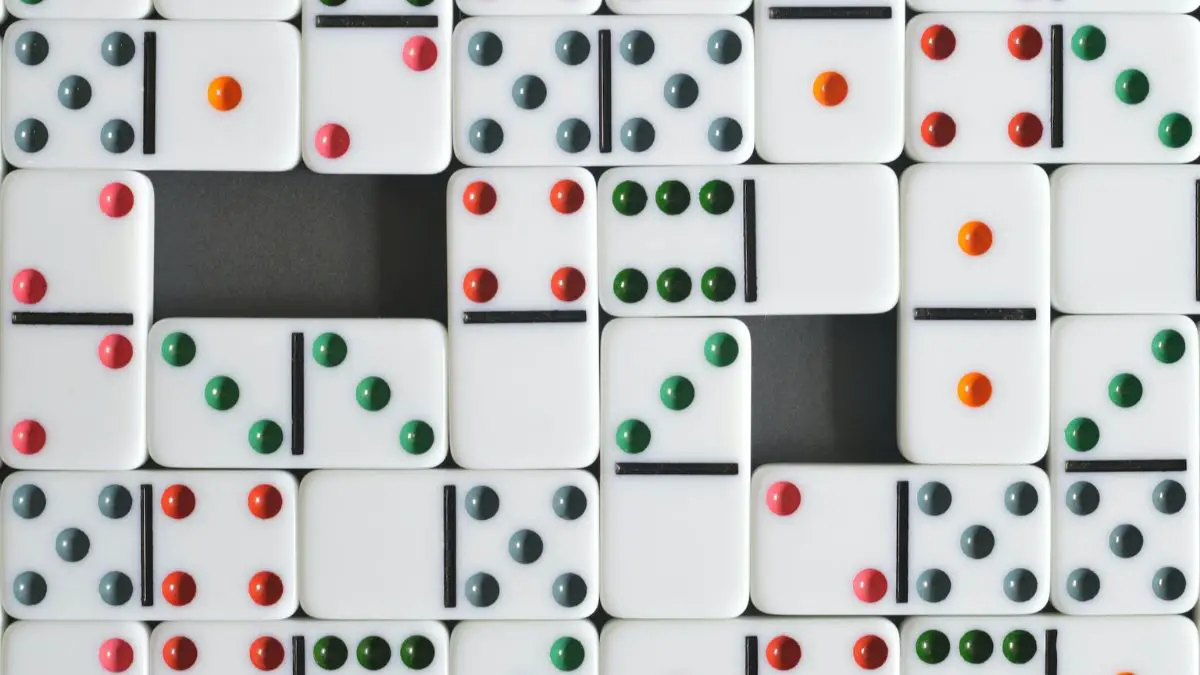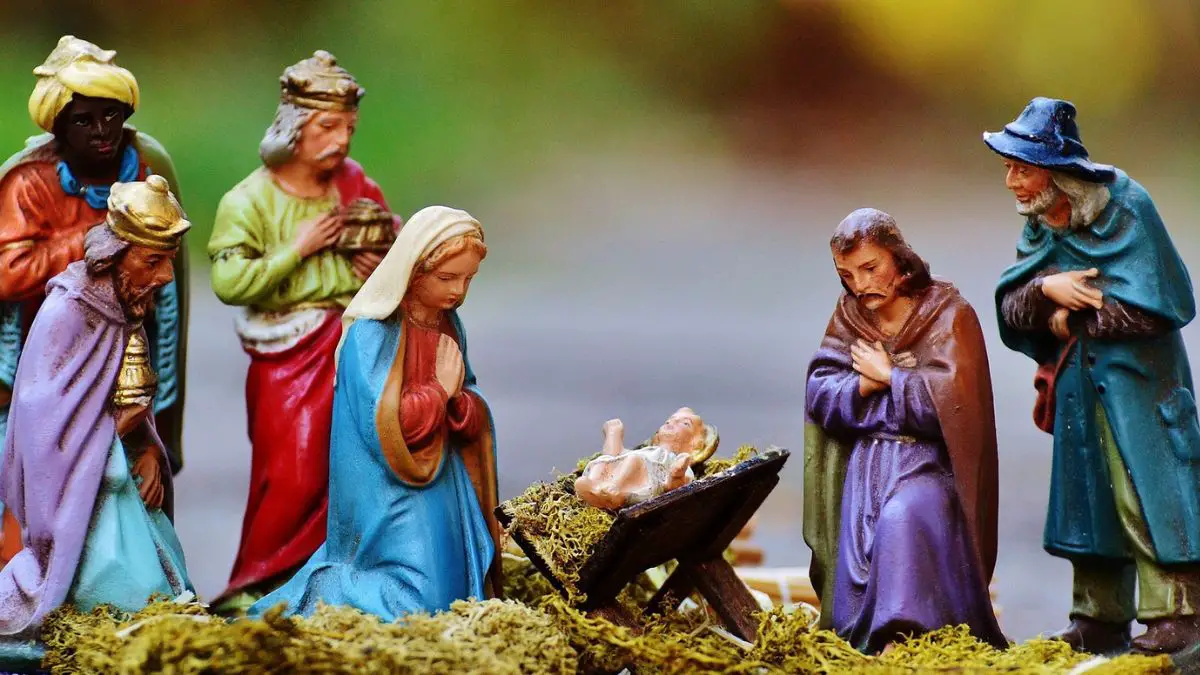Fine motor skills are a group of skills that involve the ability to make small movements, usually with the fingers and hands. (In contrast, gross motor skills are large movements such as crawling and walking).
The most important skill your baby will need to learn at this age is pincer grasp, which is the ability to grasp an object between the thumb and forefinger.
But fine motor skills affect more than just the fingers and help strengthen and develop various muscles throughout the wrists and hands.
There are a variety of different skills that your little one will need to know how to use before they reach grade school.
Building a solid foundation of fine motor skills will help your child write, draw, use scissors and other tools, tie their shoes, zip their clothes, and complete many other tasks they will need throughout their life.
Teachers and pediatricians have noticed a significant decline in fine motor skills in recent years as more and more children have been introduced to screens at a young age.
Thankfully, there are a variety of fun toys, games, and fine motor skills activities for infants that parents can facilitate at home in order to help kids develop the skills they need!
Fine Motor Skills Tips
For the greatest chance at success, be sure to model the action you would like your child to do a few times before they begin.
If your little one gets frustrated with an activity or is not yet interested, don’t push them to perform, but wait and try to introduce it again in a few weeks or months.
As you go through this list, try to select those activities that fall in line with your baby’s natural interests.
While there are a variety of baby toys that can be purchased to help develop fine motor skills, many of these activities can be completed for free with objects you already have around your house.
Other skills that are strengthened with these fun games and activities include hand-eye coordination and the importance of cause and effect.
Many of these tasks can also be adapted to become more challenging or incorporate gross motor skills as your child gets older.
Remember to always supervise your little one when doing any of the following activities…
Fine Motor Skills Activities for Infants
1) Practice Waving, Clapping & Pointing

Here is one activity that needs no props at all! You can practice these skills with your child simply by demonstration and repetition. Make it into a fun song or game to help keep your baby’s interest.
Games like Patty Cake and Peek-A-Boo can also help develop your child’s social and communication skills.
2) Encourage Dumping & Refilling
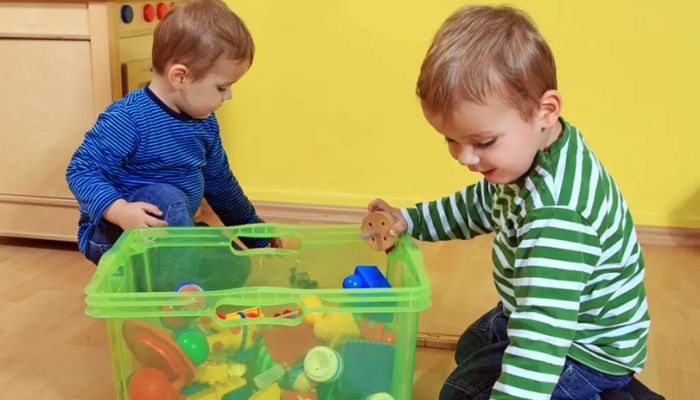
Babies and toddlers LOVE to dump and refill a bucket, box, or bag. You will probably notice your little one naturally gravitating to this activity as they pull all their books off a shelf or enjoy putting all of their stuffed animals back into a bin.
In addition to being engaging, this task is also very helpful for developing fine motor skills as your child learns how to pick up and drop objects of various shapes, weights, and sizes.
3) Make A DIY Pull Box
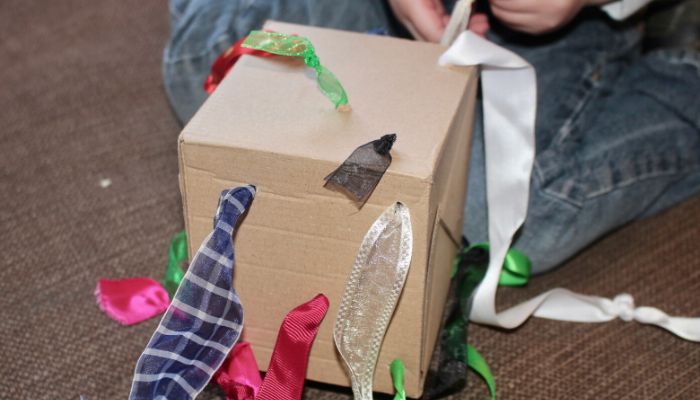
Another option to engage your child’s natural curiosity and interest in pulling things out at this stage is to make a pull box.
These can be easily made with materials you already have around the house such as a baby wipes container or a tissue box.
Fill the box with items that your child must then pull through a hole in the lid, such as baby washcloths, pipe cleaners, strings, scarves, ribbons, popsicle sticks, or fabric scraps.
Don’t be surprised if your baby wants to play with this activity for an hour or more!
Bonus: You can redirect your child to this activity whenever you find them trying to pull all the baby wipes out of the bag!
4) Play With ABC Magnets
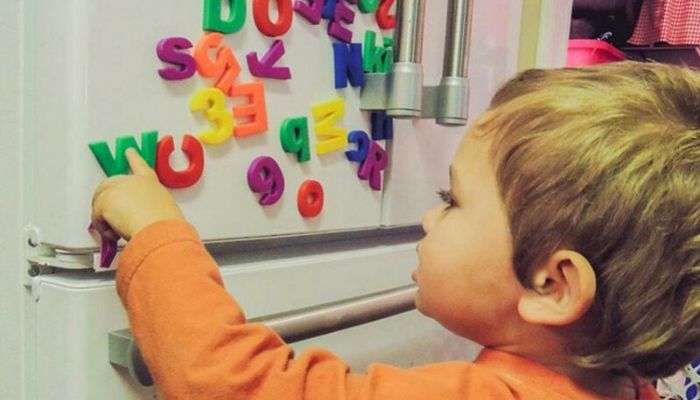
Whether you put them on the fridge or you use a cookie sheet for portability, setting up a place for magnet play is a great way to encourage fine motor skills activities for infants.
Kids who play with magnets are also learning spatial awareness and hand-eye coordination in addition to developing their hands and fingers.
5) Have Fun Finger Painting
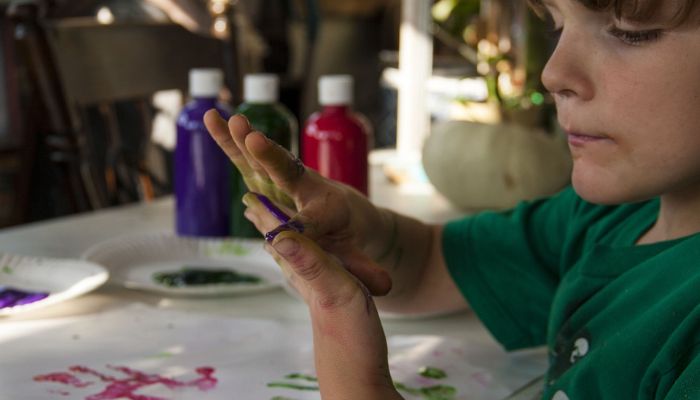
Babies as young as 6 months can experience the joys of fingerpainting with edible or food-grade colors (and proper parental supervision of course)!
You can also make DIY edible finger paint with corn starch and food coloring if you feel up for the challenge.
In addition to being a whole lot of fun, finger painting teaches your little one all kinds of useful fine motor skills.
6) Try Infant Puzzles

You may think your little one is too young for puzzles, but there are many varieties of large wooden puzzles specifically designed for babies and toddlers around the age of 1.
These puzzles usually come with large chunky pieces and include pegs or knobs to aid your child in grasping each shape.
Some puzzles may even play sounds when a piece is placed or removed to help keep your baby entertained and engaged.
7) Create A Sensory Bin
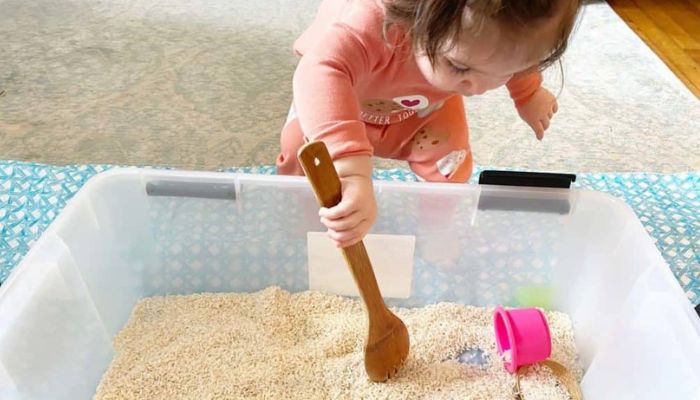
Sensory bins have become increasingly popular in recent years as a way to introduce your child to different shapes and textures while engaging the 5 senses.
But did you know they are also an excellent way to develop fine motor skills?
To create your own sensory bin at home, fill a large tray or container with objects such as dried pasta, beans or rice, large wooden beads, pom poms, etc.
Then fill the bin with toys and household items such as spoons, cups, toy cars, shovels, toy animals, and action figures.
You can also buy safe materials from educational companies like Lakeshore Learning.
** Be sure to watch your child extra closely during this activity as many of these small objects could become a choking hazard!
8) Don’t Forget the Bath Toys
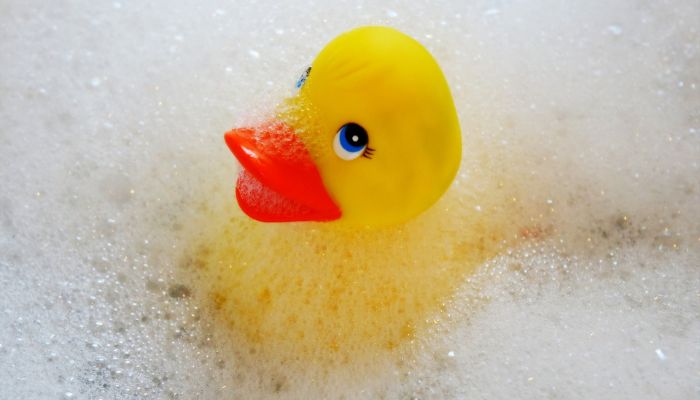
From pouring out cups of water to placing foam letters on the tub walls, bath toys are a rich source of learning and muscle development.
As your little one plays with their toys in the bath, they will develop their fine motor skills without knowing it!
9) Provide Stacking Toys

Babies and toddlers at this stage love to build up a tower to knock it down. If you don’t have blocks, stacking rings, or stacking cups, you could also use Solo cups or other household items such as old toilet paper rolls.
The act of stacking objects also helps to build gross motor skills and hand-eye coordination.
10) Peel Stickers or Tape
Some simple colorful tape on a table or highchair tray can provide hours of fun for your little one. (You may want to leave one edge slightly unstuck to help them get started).
You can also use large stickers, and as your baby gets older this activity can be adapted to taking stickers off the sheet or playing with a reusable sticker book.
11) Use Sticky Notes
Just like peeling tape, pulling a sticky note off a surface helps develop that precise pincer grasp. Simply place sticky notes within your child’s reach and encourage them to grab and pull.
(Alternatively, you could give them the pad of notes and show them how to pull off the sheets).
As your child gets older, you can even expand this activity to include gross motor skills as your toddler crawls or walks through the house to find the notes you have hidden.
12) Have Fun With Parachute Play
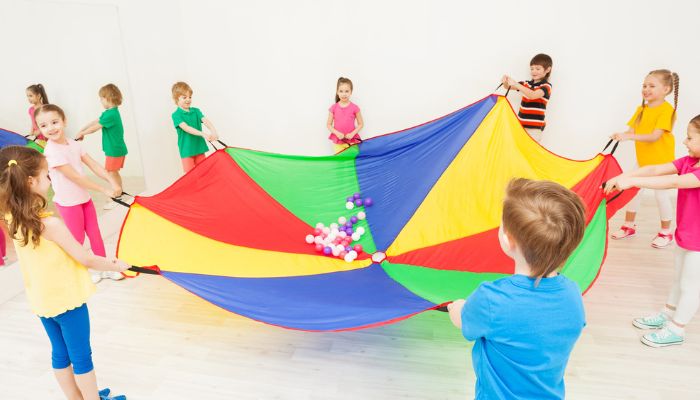
Made popular by baby musical and gymnastics programs like Gymboree, play parachutes are a great way to get the whole family involved.
Babies love to gaze at the colors and movements a parachute makes, but they can also help you grasp and shake it!
Sit your child on your lap and guide their fingers to hold the parachute handle with you. You can also sing songs, play games like Peek-A-Boo, or load up the parachute with plastic ball pit balls.
If you don’t have a parachute, you can use a bedsheet or play silks for the same purpose.
13) Practice Self-Feeding

Whether you give them some mashed baby food with a spoon or set out a plate full of baby cereal puffs, any activity that allows your child a chance to practice their self-feeding skills is a great way to develop their fine motor skills.
Children who aren’t highly motivated by toys or other fine motor activities may get more enjoyment out of practicing these new tasks when food is involved.
I know I certainly do.
14) Set Up Toy Bars & Mobiles

There is a reason why nearly every baby playmat, swing, bouncer, and walker includes brightly colored mounted or hanging toys for your little one to engage with.
Although they can be fascinating to look at, these objects are also meant to encourage your older infants and toddlers to touch, twist, pull, and grab them as they fine-tune their motor skills.
You can also buy a mobile for their crib or a toy bar for their stroller and car seat to keep the fun going anywhere.
15) Don’t Sleep on the Tummy Time

Make the best of tummy time with engaging toys that capture your baby’s attention and get their little minds (and hands) going. Tummy time is valuable for more than just the head, neck, and upper body strength.
Arm muscles and even hand muscles can be developed as your child explores the new environment around them.
In fact, studies have shown that kids who did not get enough tummy time as babies had worse handwriting once they reached grade school!
16) Try Bead Mazes
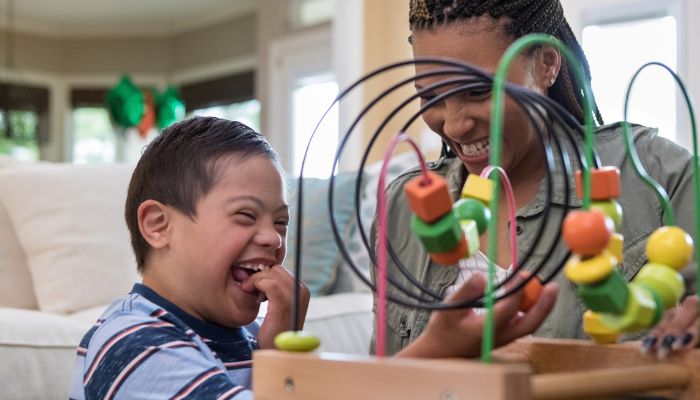
You might not have realized it before, but those simple bead mazes we all played with as kids at the doctor’s office (try not to think about the germs) are great for fine motor development.
Today, you can even buy bead mazes made just for infants. Manipulating the beads as they spin and roll across the bars is the perfect way to fine-tune that pincer grasp.
17) Encourage Scribbling
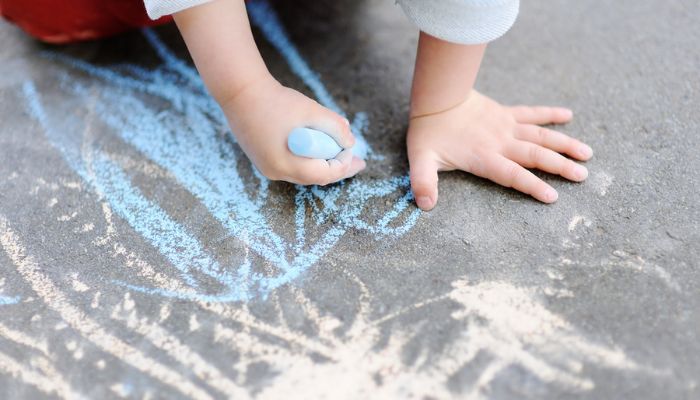
Holding a marker or a crayon helps develop the pincer grasp that your child will need throughout their life.
Various infant- and toddler-safe crayons are available that offer a great way for even the smallest children to begin practicing their drawing skills.
18) Try Baby Sign Language
Not only does teaching your child “baby signs” help develop their fine motor skills, but it also helps them learn to communicate as well.
Infants as young as 6 months old can benefit from learning a few basic signs such as “eat”, “more”, or “milk”.
19) Practice Turning Pages
Turning the pages of a book helps develop the pincer grasp as well as hand-eye coordination.
Be sure to use cloth books, board books, or Indestructible books for this activity until your little one understands how much strength is required to turn a page.
20) Roll a Ball or Toy Car
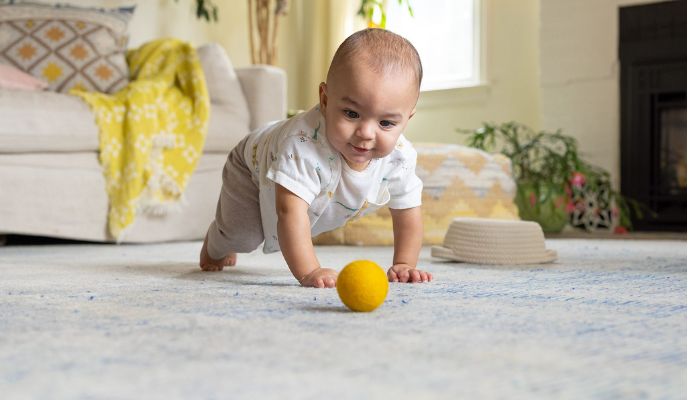
Sitting down on the ground with your child and rolling a ball back and forth is a fun and easy way to engage their attention and help them learn through play.
Although this task largely involves gross motor skills, it also requires the use of fine motor skills in order to grasp and push the ball.
Similarly, every child likes toys with wheels, and rolling a toy car across the floor is a great way to learn to manipulate objects.
21) Buy Shape Sorters
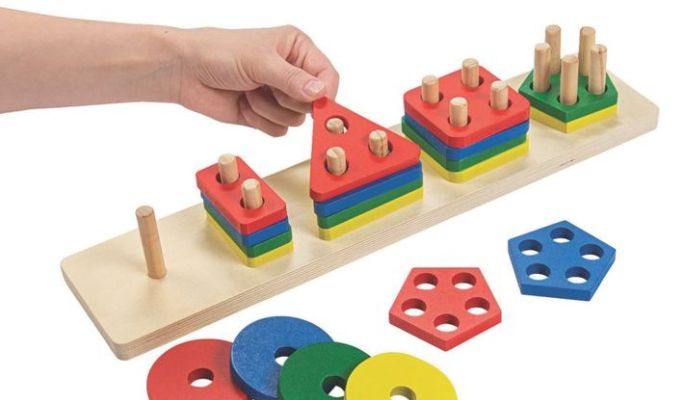
One of the best ways for babies to learn fine motor skills is by playing with shape sorters. Not only will they learn their shapes and colors, but they will develop those finger muscles too!
22) Use a Busy Board
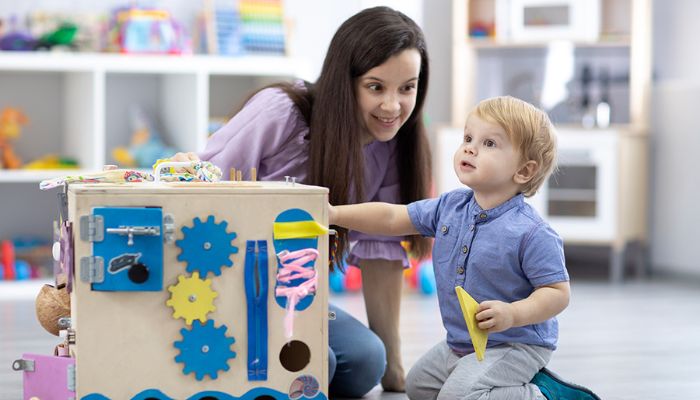
Whether you DIY or buy your own, busy boards are a great way to engage kids with various small challenges such as locks, latches, knobs, clasps, doors, zippers, switches, gears, wheels, and chains.
Not only will they need these specific skills as they get older, but these tasks also teach cause and effect, as well as help to develop muscle strength and hand-eye coordination.
23) Play With Blocks
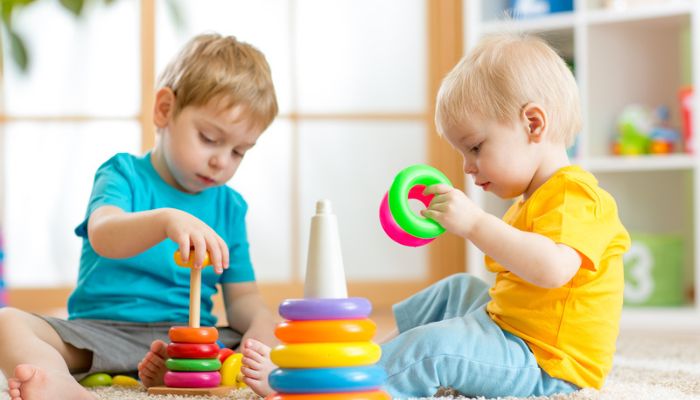
Whether they build a masterpiece or knock it down, blocks help keep kids of all ages engaged and learning how to grasp objects of different shapes and sizes. Soft blocks are a great option for young infants and toddlers.
24) Play with Play-Doh
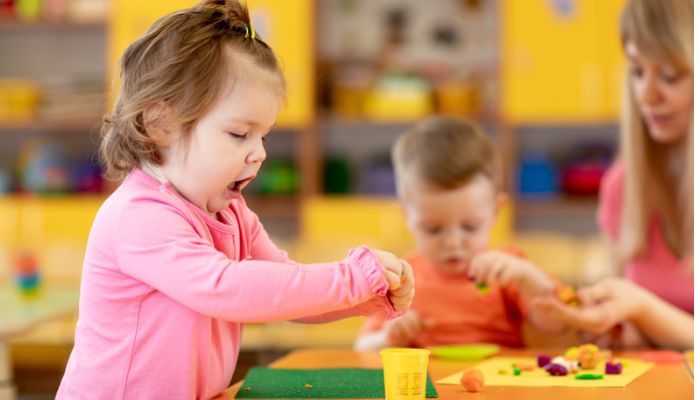
This childhood classic and favorite of kids and parents everywhere is one of the best ways your child can learn fine motor skills and strengthen their hand muscles.
They are learning valuable movements and fine motor tasks as they push, pinch, roll, and otherwise manipulate the dough.
Note: Sensory bags also serve the same purpose and offer many of the same benefits as Play-Doh!
25) Encourage Tearing Paper/Unwrapping

Babies and toddlers love to tear paper! Tearing paper helps to develop the pincer grasp and strengthens your child’s hand muscles through pulling.
Presenting your child with an object to unwrap gives them an appropriate outlet for this activity. You can wrap your child’s toys or household objects or buy cheap items from the Dollar Store to wrap them.
Wrapping it Up
Although children today might seem different because of their exposure to iPads and computers at an early age, the great thing is, you can still raise your child to have the skills they’re meant to have!
Just follow this guide, and you can’t go wrong.
We hope you enjoyed today’s post on the best fine motor skills activities for infants. Stay tuned for the next one!


